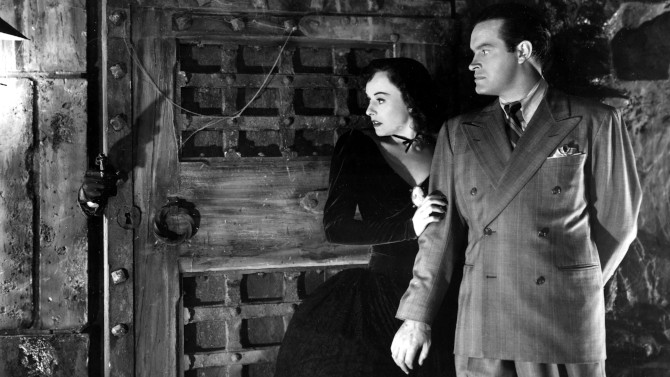
Voodoo, and Zombies, and Ghosts, Oh My
Beating the famed comedy duo of Abbott and Costello to the horror comedy circuit both one and two years prior to their 1941 classic Hold That Ghost, Bob Hope released The Cat and the Canary in 1939, following it up in quick succession (just eight months later) with The Ghost Breakers in 1940 – it was originally a play written by Paul Dickey and Charles W. Goddard (there are also two silent films from 1914 and 1922 based on it that are thought to be lost – the former being directed by Cecil B. DeMille). Directed by George Marshall, the mystery infused horror comedy follows a socialite, Mary Carter (Paulette Goddard), who has learned on a stormy New York night that she has inherited a supposedly haunted castle on a secluded Cuban isle ominously named Black.
-

Beyond the See
A Quiet Place Part IIOctober 19, 2021It’s not easy for kids to grow up – especially in an alien apocalypse. . . after all, what are they to do without Instagram and TikTok. All kidding aside, 2020's A Quiet Place Part II turns the focus on the children, to great effect. Once again written (this time on his own) and directed by John Krasinski, he makes the smart decision to open with a flashback that shows day one of the alien invasion. . . an adrenaline pumping action sequence featuring a lengthy one take car scene, both chaos and quiet hiding, as well as introducing us to a new character from the Abbott’s community, Emmett (Cillian Murphy).
-

Conjuring Up a Threequel
The Conjuring: The Devil Made Me Do ItOctober 17, 2021Bookending the film with what amounts to two climactic sequences, The Conjuring: The Devil Made Me Do It (also known as The Conjuring 3), released this 2021, opens with what very well could have been the ending of a previous film. . . this moment becoming the genesis to push the story forward. For the first time not directed by James Wan (though he co-writes and produces), Michael Chaves takes up the mantle – doing a pretty seamless job. Expect the same intriguing over the head angles, spectral pov shots, long location tracking shots, and spooky camera pans. . . though it is definitely not as flashy as Wan, it does the trick.
-

He Who Must Not Be Named
The Return of the VampireOctober 12, 2021It has long been lamented that Bela Lugosi only donned the cape once as Universal’s Dracula (excluding the much later comedy Abbott and Costello Meet Frankenstein), whereas their two other most famous creatures, the Frankenstein Monster and Wolf Man, were brought back to life a number of times by Boris Karloff and Lon Chaney Jr. respectively. Instead, for budgetary reasons, they cut Lugosi out of the sequel (Dracula’s Daughter – reviewed here on Filmizon this month), eventually giving the role to other actors (Chaney Jr. and John Carradine) until he finally returned to the role in 1948 in the above mentioned comedy. Yet, to say there is no true sequel to Dracula is not completely true. Columbia Pictures, looking to capitalize on the horror craze, aimed at producing a sequel to the Universal product. . . after being threatened with a lawsuit, they went ahead anyway – simply changing the Dracula name. Titled The Return of the Vampire (1943), B movie specialist Lew Landers was put in charge of directing the low budget fare.
-

A Satanic Sanguineous Sexcapade
Satan's BloodOctober 8, 2021A bit like Rosemary’s Baby on Viagra – well, not really. . . there’s no way this quickie production could afford anything other than no name brand, 1978's Satan’s Blood, written and directed by Carlos Puerto (uncredited direction comes from producer and horror auteur Juan Piquer Simón), brings horror sexploitation all the way to a bloody climax. It's also a wonderful guide in what not to do in a horror movie:
-

Missed the Bloody Cut: 2021 (Part 2)
October 5, 2021Part 2 of my Missed the Bloody Cut horror selections, here are some more horror movies that did not meet my strict criteria (a rating of 7.0 or higher). . . but are still entertaining films (horror fanatics may enjoy) that do not deserve to be forgotten like that spooky attic (that may be hiding more than just dust) – and that they are definitely worth a watch (just maybe not several re-watches).
-

Trapped Door
The Strange DoorOctober 2, 2021A melodramatic horror thriller with more than a tinge of romance, 1951's The Strange Door, directed by Joseph Pevney, and based upon Robert Louis Stevenson’s “The Sire de Maletroit’s Door”, pairs together two all-time legends to great effect. Set outside of Paris in the 17th century, Charles Laughton is Sire Alain de Maletroit, the fattest cat in the region. Prancing around his expansive castle (adorned with a trap front door that cannot be opened from the inside – talk about strange), he is, in fact, quite like a feline – hopping up onto furniture, leaning against walls, demonstrating a playful if menacing flamboyant attitude to anyone he meets. Surrounded by a group of equally as vile ‘yes’ men, they thrive off of Maletroit’s malice.
